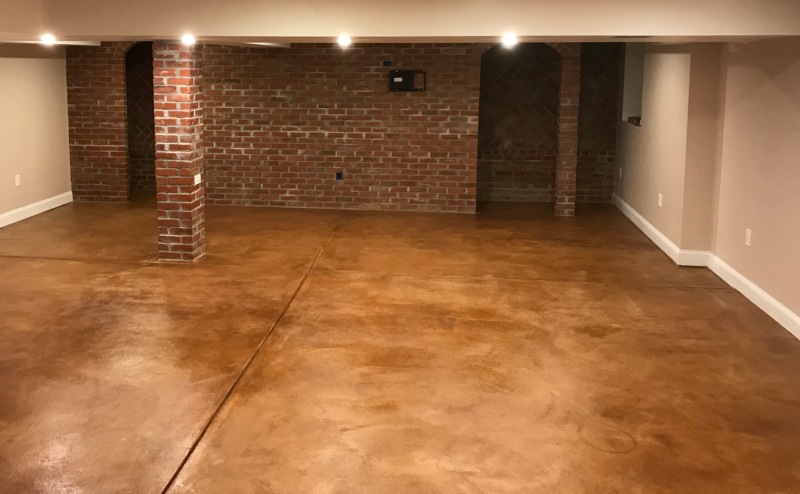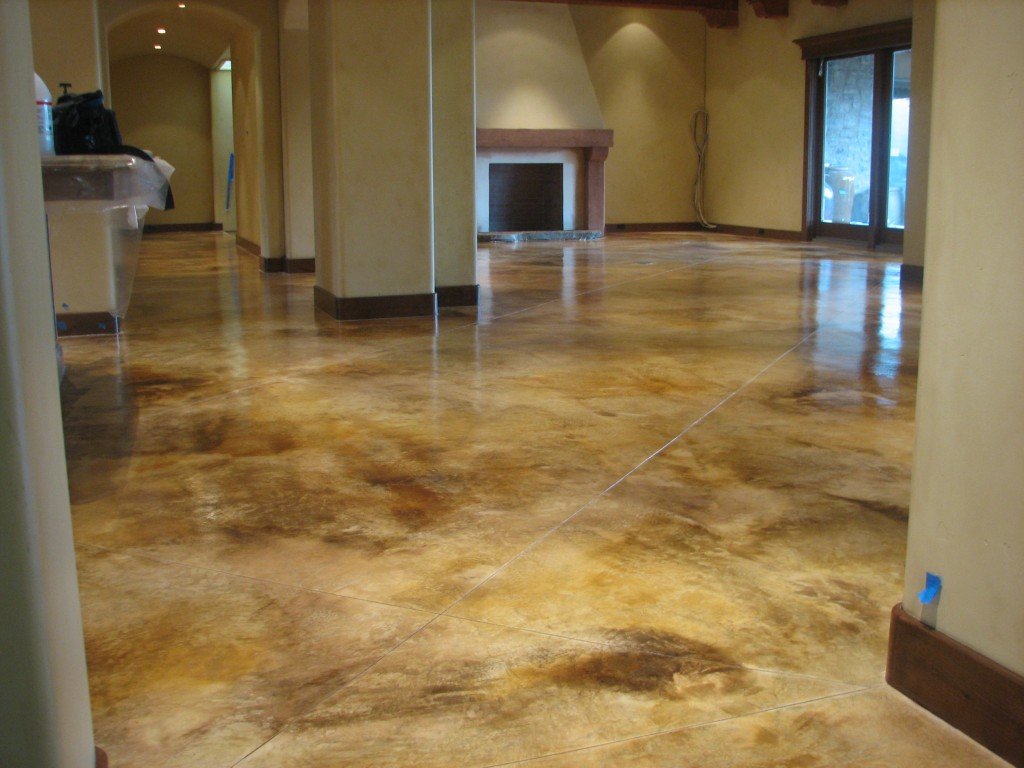The top design trends for stained concrete floors austin
Wiki Article
Comprehending the Various Sorts Of Stained Concrete for Your Next Task
Stained concrete offers various choices that deal with various aesthetic and useful requirements. Each kind presents distinctive attributes that influence the last appearance and durability of the surface area. Comprehending these distinctions is essential for any person preparing a project. From abundant, chemical responses of acid-based stains to the dynamic harmony of solid shade stains, the choices can significantly impact the end result. What variables should one take into consideration when picking the excellent tarnish for their particular needs?Introduction of Stained Concrete
Stained concrete acts as a functional floor covering choice that can enhance the visual charm of various areas. This strategy involves using a coloring representative to the surface of existing concrete, permitting a wide spectrum of layout opportunities. Stained concrete is preferred in both residential and industrial environments, using a durable and low-maintenance service that can mimic the look of all-natural products like stone or floor tile.The staining process can be executed utilizing water-based or solvent-based items, each offering distinctive visual impacts. The last look is influenced by factors such as the original concrete surface area, the kind of stain utilized, and the application technique. Stained concrete not only enhances exterior and interiors but also advertises sustainability by rejuvenating existing concrete structures. Therefore, it has obtained grip among house owners and developers looking for both performance and style in their flooring options.
Acid-Based Stains: Features and Advantages

Distinct Color Variations
Concrete surface areas can change substantially with the application of acid-based stains, which provide an abundant scheme of distinct shade variations. These stains permeate the concrete, responding chemically to produce lively planet tones that range from deep browns and reds to soft environment-friendlies and blues. The resulting hues are frequently variegated, creating a natural, marble-like look that boosts the concrete's personality. Each application yields distinctive outcomes due to variations in the concrete's composition and the discoloration strategy made use of, making every task distinct. Furthermore, acid-based stains can be split or incorporated with other strategies to develop tailored layouts, permitting personal expression. This flexibility makes acid-based stains a popular choice for both household and business applications.Chemical Responses Clarified
While many aspects add to the efficiency of acid-based stains, the underlying chemical responses play an essential duty in their special qualities and advantages. These stains largely contain water, acid, and metal salts. When put on concrete, the acid reacts with the calcium hydroxide in the cement, creating a chemical transformation that causes permanent color changes. The metal salts permeate the surface and bond with the concrete, permitting a wide array of hues and tones. This response not just improves aesthetic allure however also provides toughness, making the shade resistant to fading and wear. Additionally, acid-based stains can create a variegated coating that imitates natural rock, additional enhancing their popularity for attractive concrete applications.Surface Area Preparation Significance
Achieving excellent outcomes with acid-based stains pivots on detailed surface area preparation. This essential action guarantees that the concrete surface area is tidy, devoid of pollutants, and properly profiled for suitable discolor absorption. Any type of existing sealants, dirt, or oils can prevent the chemical reaction that generates the desired shade and finish, bring about unequal or uneven results.Prior to applying the tarnish, the concrete should be mechanically cleansed or pressure cleaned, adhered to by a thorough assessment for cracks or blemishes that may require repair work. In addition, confirming the surface is effectively dried will enhance tarnish adherence. By prioritizing these primary measures, the long life and vibrancy of acid-based stains can be substantially improved, leading to a much more aesthetically pleasing and resilient surface.
Water-Based Stains: Attributes and Benefits

Water-based stains permeate the concrete, supplying a more clear coating that highlights the natural structure and variants of the surface area underneath. They are offered in a large array of colors, enabling creative versatility in layout. Additionally, water-based stains are simpler to tidy up, requiring just water and soap, which simplifies the application process.
Their quick drying out time boosts efficiency, making them a functional selection for both do it yourself enthusiasts and professionals. On the whole, water-based stains provide an attractive combination of visual versatility and easy to use homes, making them a preferred alternative for concrete enhancement projects.
Solid Color Stains: Dynamic Choices for a Bold Look
Strong color stains provide an efficient option for those looking for to produce a strong and lively visual on concrete surface areas. These stains provide an uniform coloration that can substantially boost the aesthetic allure of floorings, patio areas, and driveways. Readily available in a vast range of colors, strong shade stains permit imaginative expression, dealing with numerous layout choices.Among the key benefits of strong color stains is their capability to hide flaws, giving a fresh and refined appearance to maturing concrete - Austin Stained Concrete Floors. In addition, their formula usually includes UV-resistant residential properties, guaranteeing longevity and color retention even in rough weather
Application is straightforward, requiring minimal preparation of the concrete surface area. Once applied, solid color stains can be sealed for included protection and sheen, more boosting their aesthetic quality. With their lively choices, strong shade stains are an outstanding click here choice for those going for an impactful and natural design.
Semi-Transparent Stains: Attaining Depth and Measurement
Semi-transparent stains use an one-of-a-kind technique to improving concrete surface areas by offering deepness and dimension via various shade choices. Comprehending the application techniques is vital for achieving the wanted effect, while appropriate upkeep methods assure longevity. This area will certainly explore these crucial aspects to maximize the benefits of semi-transparent discoloration.Color Options Available
A variety of shade options exists for semi-transparent stains, enabling homeowners and designers to improve the all-natural beauty of concrete surfaces. These stains can be found in an array of shades, from natural tones like browns and terracottas to vivid colors such as blues and environment-friendlies. The semi-transparent nature of these stains allows the underlying concrete to show with, creating a special deepness and measurement that can match different layout aesthetic appeals. In addition, incorporating different colors can create custom-made tones, making it possible for a tailored look for each job. This adaptability makes semi-transparent stains a prominent option for both indoor and outside applications, as they can balance with surrounding components while including aesthetic rate of interest to ordinary concrete.Application Strategies Clarified
To accomplish the preferred deepness and dimension with semi-transparent stains, appropriate application strategies are vital. Surface area preparation is essential; the concrete must be tidy and free of any kind of contaminants. This commonly entails power cleaning and fixing any fractures. Next off, choosing the right applicator, such as a sprayer, roller, or brush, can influence the final look. Sprayers enable for a more also application, while rollers can help achieve appearance. It is essential to apply the stain in thin, even layers, permitting each layer to dry before adding another. Controling the application strategy, such as varying stress or using various tools, can produce unique results. Sealing the stained surface area improves the vibrancy of the shades while providing defense.Maintenance Best Practices
Normal maintenance is necessary for preserving the appeal and integrity of surfaces treated with semi-transparent stains. To keep these surfaces, regular cleansing is important. Making use of a pH-neutral cleaner and a soft-bristle broom will aid remove dust and debris without harming the stain. It is recommended to prevent harsh chemicals, as they can break down the tarnish's appearance. Furthermore, routine resealing every one to 3 years can secure versus wear and fading. This procedure involves cleaning up the surface area extensively and using a compatible sealant designed for stained concrete. Homeowners must additionally monitor for any type of indications of staining or damages and address these concerns promptly to ensure durable vibrancy and longevity. Following these finest methods will certainly boost the total lifespan of semi-transparent stained surfaces.Effects and Methods: Tailoring Your Stained Concrete
Customizing stained concrete involves a range of techniques that improve both visual appeals and performance. Among these techniques, layering various discolor colors can produce depth and complexity, permitting for one-of-a-kind aesthetic effects. Techniques such as acid staining provide a variegated appearance, while water-based stains offer an extra consistent appearance.Furthermore, including ornamental patterns, such as stenciling or inscription, can even more individualize the surface area, including elaborate designs that satisfy private tastes. Texturing the concrete, whether via marking or broom coatings, introduces tactile aspects that not only improve grasp but likewise boost aesthetic rate of interest.
Applying sealants can enhance the color vibrancy and supply security against wear. Customization strategies extend past mere shade; they can change a typical concrete slab into a magnificent centerpiece, making it appropriate for both property and commercial areas. Through mindful choice of effects and techniques, stained concrete can attain a genuinely tailored appearance.
Maintenance and Longevity of Stained Surfaces
Although stained concrete surface areas are known for their resilience and visual appeal, preserving their honesty is vital for guaranteeing longevity. Routine cleansing is crucial; sweeping and mopping with a pH-neutral cleaner helps stop dust buildup and staining. In addition, applying a sealer every couple of years can shield the surface from wetness, chemicals, and UV damages, consequently enhancing its life-span.It is likewise important to deal with any type of splits or chips quickly. Small repair services can minimize further degeneration, maintaining the aesthetic and structural quality of the surface. For exterior stained concrete, seasonal upkeep, such as removing snow and ice, is required to stop surface area damages from freeze-thaw cycles.
Regularly Asked Questions
Can I Tarnish Existing Concrete Surfaces or Brand-new Ones?
The concern of whether existing concrete surfaces can be stained emerges often. It is certainly feasible to tarnish both new and old concrete, provided the surface area is sufficiently prepared and totally free of contaminants for excellent bond.For how long Does the Discoloration Process Generally Take?
The staining process typically takes one to 3 days, depending on factors such as surface area preparation, sort of stain, and weather. Stained Concrete Austin. Healing time might extend beyond first application, affecting the overall duration significantlyIs Stained Concrete Safe for Outdoor Usage?
Stained concrete is usually risk-free for outdoor use, supplied it is properly sealed. This securing secures against moisture and UV damages, guaranteeing sturdiness and safety and security, while also improving the visual appeal of outside areas.Can I Apply Several Stain Layers for Various Effects?
Using numerous stain layers can accomplish diverse effects on stained concrete. Nevertheless, it is necessary to ensure compatibility in between stains and permit proper drying time in between applications to avoid unintended reactions or discoloration.Are There Any Shade Limitations for Stained Concrete?
Color restrictions for stained concrete mostly rely on the sort of discolor used, with water-based stains supplying a broader palette compared to acid-based stains. Stained Concrete Floors Austin. Attaining vivid shades might call for cautious choice and application techniques.Report this wiki page